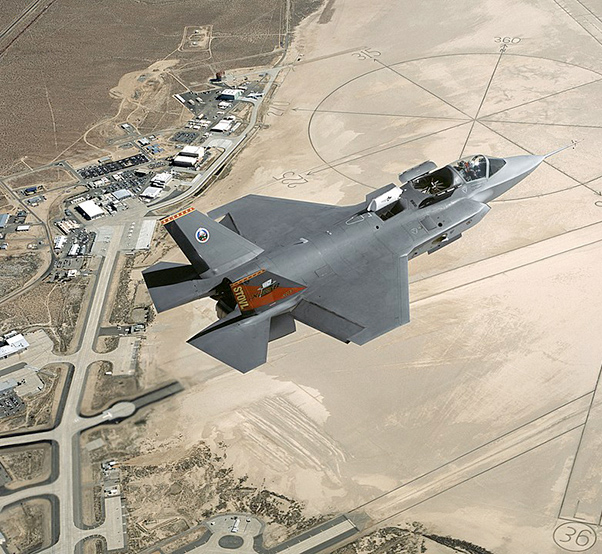
By Larry Grooms, special to Aerotech News
When the veils are lifted from Lockheed Martin’s invention of the Joint Strike Fighter, the wizard-in-chief is revealed to be a man who could speak, interpret and organize the language of aerospace specialties.
Although Dr. Paul Bevilaqua, the man behind the curtain as former chief engineer for the Lockheed Martin Skunk Works, has told the story of the XF-35 invention many times to industry groups, he reached a wider audience Oct. 10 in an online webinar produced by the American Institute of Aeronautics & Astronautics Los Angeles/Las Vegas Section.
Bevilaqua explained the challenge in creating the Joint Strike Fighter was performing a modern miracle by designing a multi-role, single engine air superiority fighter capable of both vertical and short field takeoff and landing and achieving supersonic speed. And the level of difficult rose a few notches with requirements that the new fighter would meet the mission requirements of the U.S. Air Force, Navy and Marine Corps, as well as defense forces of friendly nations. And the final product had to be thrifty.
Remembering the whole history of aircraft design, starting with the bicycle-building Wright Brothers, Bevilaqua showed what he called “the wheel of misfortune” depicting 50 earlier attempts to invent an aircraft that could reliably take off and land vertically while still performing useful work. He said only one design succeeded, the British designed AV-8B Harrier jump jet that required top cover because its top speed was subsonic.
Bevilaqua, with advanced degrees in mathematics and aero engineering, said the first step was correctly stating the problem. “The way you state the problem determines the solution.”
The solution in the case of the F-35 required finding ways to accomplish each step in a process based upon associating knowns with creative thought in every facet of the program, including coordination between Skunk Works working groups. Bevilaqua noted that creative manufacturing projects must guard against errors caused by misunderstandings between design, fabrication and manufacturing, marketing and other groups.
Although the Joint Strike Fighter program called for a commonly shared airframe, variations were required for different customers. The Marine Corps variant required special thrust vectoring, propulsion cycling from turbofan to turbo shaft mode for VTOL operation and an alternative jet engine for greater thrust. The propulsion system made the X-35 the first aircraft both fly supersonic and hover and land vertically. The development team won the Collier Trophy, which recognizes “the greatest achievement in aeronautics or astronautics in America” each year.

The Air Force version is stealthier and the Navy variant has more wing area and beefed-up airframe for carrier landings and takeoffs.
But even the best laid plans for cutting-edge research and development work to protect the nation unfortunately carry unhappy surprises on the back end.
Bevilaqua expressed two primary threats to happy landings for aerospace defense contractors. The first is cautioned about in the Skunk Works philosophy: “One miracle per program.” Technological miracles, such as making it possible for a jump jet to fly supersonic is about all any contractor can afford.
In the case of the F-35, Lockheed Martin used off-the-shelf technologies and components wherever they met requirements at the most affordable cost.
The second and potentially most costly threat to return on investment is found in the expression, “The high cost of a little more.”
Bevilaqua said the biggest financial problem to hit the F-35 program was the cost of agreeing to accept a new helmet display, which added substantially to the cost of the program without any productive outcome.
Such budget busting change and gold-plated add-ons can be driven externally or internally, Bevilaqua mentioned. From the customer’s perspective, “They want everything. They just don’t want to pay for it.”
And from the internal product development and marketing side, there is the too helpful sales pitch for an unnecessary gizmo or too fast agreement to a customer’s demand for an unneeded change.
No matter where the financial change hits, the defense contractor is exposed to the dreaded Pareto Principle of the 80/20 Rule, which roughly states, “the last 20 percent of the program drives 80 percent of the cost.”
Bevilaqua pointed out that as has been seen in other recent aerospace technology leaps, including the B-2, “as the cost of weapons goes up, the number of units goes down.”
Although the unit costs of the F-35s coming off assembly lines have reportedly dropped in recent years, operational budgets for the fleet are reported to be increasing.
"creation" - Google News
October 23, 2020 at 02:01AM
https://ift.tt/31BDBzw
Lessons from the mind that guided the creation of the F-35 - Aerotech News
"creation" - Google News
https://ift.tt/39MUE4f
https://ift.tt/3bZVhYX
Bagikan Berita Ini














0 Response to "Lessons from the mind that guided the creation of the F-35 - Aerotech News"
Post a Comment